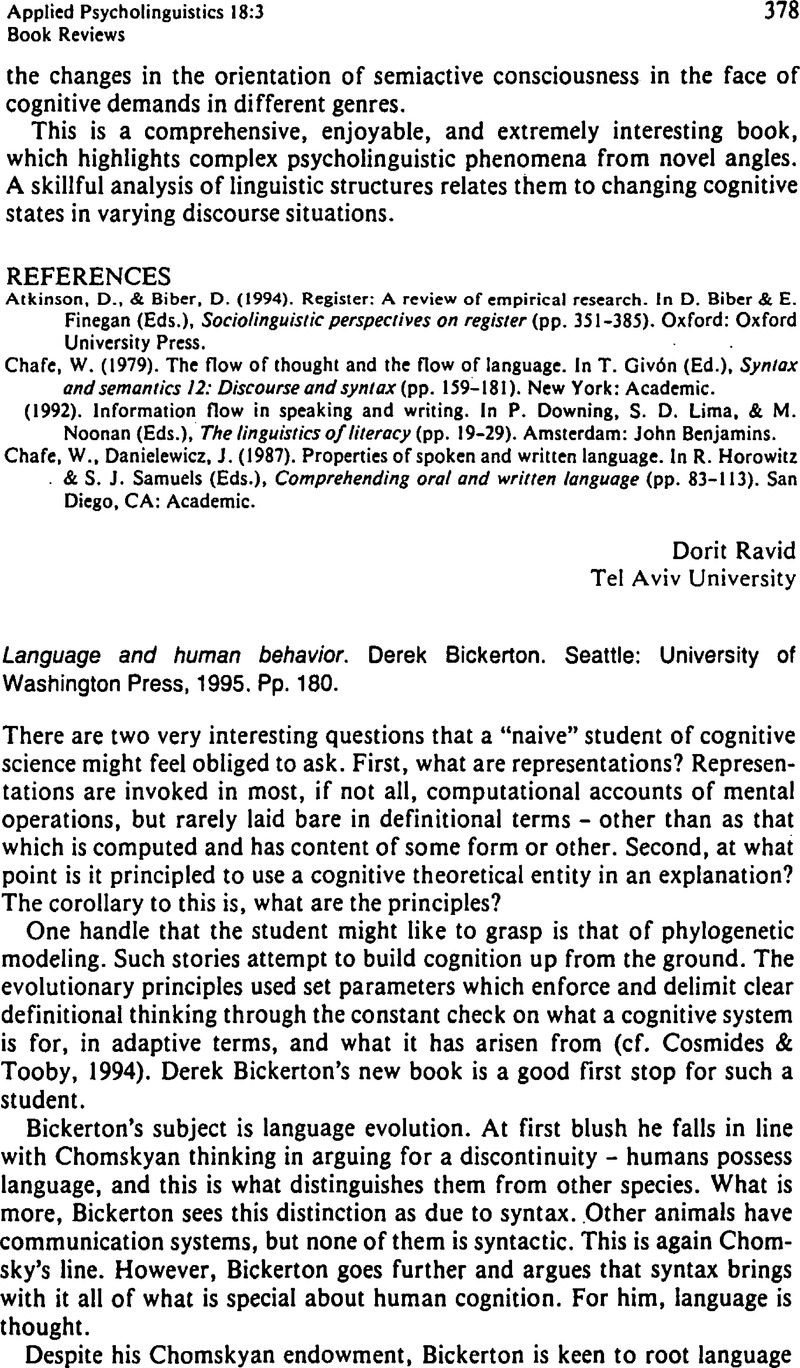No CrossRef data available.
Article contents
Language and human behavior. Derek Bickerton. Seattle: University of Washington Press, 1995. Pp. 180.
Published online by Cambridge University Press: 28 November 2008
Abstract
An abstract is not available for this content so a preview has been provided. Please use the Get access link above for information on how to access this content.

- Type
- Book Reviews
- Information
- Copyright
- Copyright © Cambridge University Press 1997
References
REFERENCE
Bickerton, D. (1990). Language and species. Chicago: University of Chicago Press.CrossRefGoogle Scholar
Carruthers, P. (1996). Thinking in language? A plethora of possibilities; a paucity of evidence. Unpublished manuscript circulated prior to the Hang Seng Conference, Sheffield, June 1996.Google Scholar
Cheney, D. L., Seyfarth, R. M. (1990). How monkeys see the world: Inside the mind of another species. Chicago: University of Chicago Press.CrossRefGoogle Scholar
Cosmides, L., Tooby, J. (1994). Beyond intuition and instinct blindness: Toward an evolutionary rigorous cognitive science. Cognition, 50, 41–77.CrossRefGoogle ScholarPubMed
Dennett, D. C. (1984). Elbow room: The varieties of free will worth wanting. Oxford: Clarendon Press.Google Scholar
Dickins, T. E. (in press). [Review of R. Ounbar (1996) Grooming, gossip and the evolution of language]. British Psychological Society, History and Philosophy of Psychology Newsletter, 23 (Autumn), 38–43.Google Scholar
Dretske, F. (1986). Misrepresentation. In Goldman, A. I. (Ed.), (1993), Reading in philosophy and cognitive science. Cambridge: MIT Press.Google Scholar
Dunbar, R. I. M. (1993). Coevolution of neocortical size, group size and language in humans. Behavioural and Brain Sciences, 16, 681–735.CrossRefGoogle Scholar
Dunbar, R. L. M. (1996). Grooming, gossip and the evolution of language. London: Faber & Faber.Google Scholar
Fodor, J. A., Pylyshyn, Z. W. (1988). Connectionism and cognitive architecture: A critical analysis. In Pinker, S. & Mehler, J. (Eds.), Connections and symbols. Cambridge: MIT Press.Google Scholar
Harnad, S.(1995). The origin of words: A psychophysical hypothesis. In Durham, W. & Velichkovsky, B. (Eds.), Communicating meaning: Evolution and the development of language. Hillsdale, NJ: Erlbaum.Google Scholar
Harnad, S. (1996). Experimental analysis of naming behaviour cannot explain naming capacity. Journal of the Experimental Analysis of Behaviour, 65(1), 262–264.Google Scholar
Lloyd-Morgan, Conwy. (1894). An introduction to comparative psychology. London: Scott.Google Scholar
Pinker, S. & Bloom, P. (1990). Natural language and natural selection. Behavioural and Brain Sciences, 13, 707–784.CrossRefGoogle Scholar
Savage-Rumbaugh, E. S. (1986). Ape language: From conditioned response to symbol. New York: Columbia University Press.CrossRefGoogle Scholar
Studdert-Kennedy, M. (1992). Leap of faith: A review of Language and species. Applied Psycholinguistics, 13, 515–527.CrossRefGoogle Scholar


